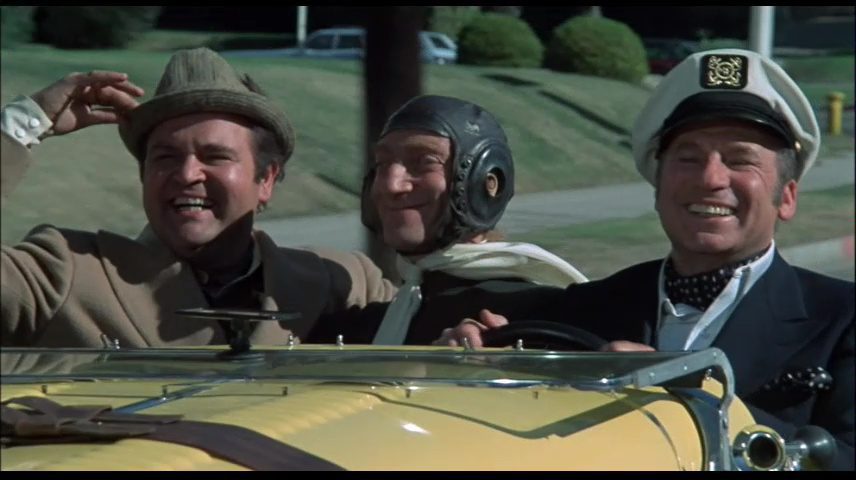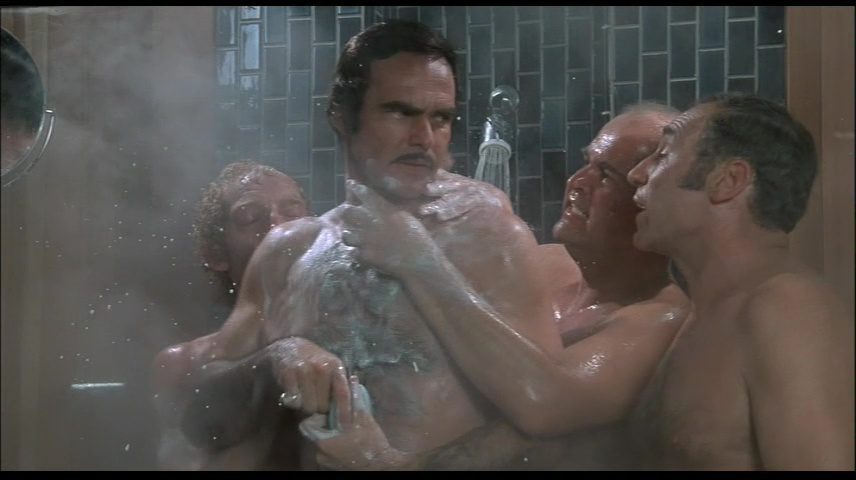The seventies were, as cinephiles and casual fans alike know well, an exciting decade for moviegoers. Most discussion of the decade tends to focus on the New Hollywood auteurs and the big-budget summer blockbusters, some on the Blaxploitation cycle or the influx of martial-arts films. It’s easy to overlook a filmmaker whose comedies thrived at the box office and challenged their viewers. And no, I don’t mean Woody Allen, who was at the time a critical darling. I mean Mel Brooks, who could follow up an unsurpassable 1974—the classics Blazing Saddles in February and Young Frankenstein in December—with another box-office hit, Silent Movie, in 1976.
Though Silent Movie won over critics and audiences upon its initial release, it’s admittedly nowhere near the film either Blazing Saddles or Young Frankenstein is. Those two hits, each so adroitly parodying recognized film genres with clever storylines, elaborate visuals, comic gags, and genuine insight and pathos wrought by excellent scripts and performances, set a standard practically unparalleled for film comedy. Both lovingly recreate the mise-en-scène of the genre standards—Blazing Saddles the deeply saturated Technicolor panoramas of John Ford’s Westerns, Young Frankenstein the chiaroscuro black-and-white gothic horror of James Whale’s Universal classics—only to punctuate their genre tropes with elaborate visual gags and memorable characters.
Both of those films did big box office: on its minuscule $2.6 million budget, Blazing Saddles earned a whopping $119.6 million in North American receipts, while Young Frankenstein pulled in $86.2 million on a similar budget. As importantly, both films have remained prominent in our collective cultural memory ever since, appearing on dozens of “Best of …” lists, their release anniversaries celebrated, deluxe physical packages released, special screenings, critical articles, and more. When Blazing Saddles became an unlikely source of cancel-culture controversy in 2020, it’s not because of any inherent racism (it’s one of the decade’s avowedly anti-racist comedies) but because of its rich legacy and status.

Both films, I’ll add, succeed in part because of the highly specific genres they imitate. Blazing Saddles lampooned all the hoary gunslinger tropes of the Western’s saloon brawls, shootouts, hangings, and wilderness-versus-civilization thematics with a black protagonist—Cleavon Little’s Sheriff Bart—complicating the narrative. With its clever set design and evocative lighting, Young Frankenstein focused tightly on the first two Universal Frankenstein films, repurposing original props, employing a 1930s editing aesthetic, and even using a period score to compliment its narrative of a mad scientist bringing life to the inanimate. Both genres—the Western and the Gothic horror film were still prominent in the 1970s, popular in episodic television and reruns.
The same can hardly be said of the silent films that Brooks would lampoon in his follow-up. Silent film, having been the predominant mode of cinematic storytelling from 1895-1928, evolved into its own art form, but it was never a specific narrative genre with identifiable tropes like the Western or Gothic horror: a silent film might have been either of those, a melodrama, a swashbuckler, or a historical epic. And in the 1970s, silent films were no longer prominent on television or in theaters. So that Brooks was able to make a box-office success of Silent Movie is something of its own minor miracle: it was, in comparison, a modest success earning over $36 million on its $4 million budget.

On the surface, the film’s plot may seem treadworn, a slapstick version of let’s-put-on-a-show. Brooks himself stars as Mel Funn, a down-on-his luck once-great director hoping to make his big Hollywood comeback with the help of sidekicks Dom Bell (Dom DeLuise) and Marty Eggs (Marty Feldman). Their big idea: the first silent movie in forty years. To save Big Pictures Studio from a hostile takeover by Engulf & Devour, the studio chief (Sid Caesar) agrees: if Funn and his crew can enlist Hollywood’s biggest stars, he’ll greenlight the film, and it just might save the studio.
Granted, that plot is little more than an excuse for the trio to traipse around in their vintage roadster collecting cameos, each of whom plays themselves riffing on their own individual star personae. The cast list isn’t exactly Hollywood’s “biggest” stars (Pacino, DeNiro, Douglas, Fonda, Keaton, Nicholson are nowhere to be found), but they’re not your proverbial chopped liver, either. Burt Reynolds showering, James Caan boxing, Liza Minnelli showboating, Paul Newman racing, Anne Bancroft smoldering—you get the idea. Some of their gags are loads of fun, such as the trio lathering up the hirsute Reynolds in a shower, hand-by-hand, playing on his naked-on-the-bearskin 1972 Cosmopolitan spread.

Paul Newman’s race around a convalescent home is good fun too, as is Bernadette Peters wowing a crowd with her showgirl act. Others have less to do: Sid Caesar is limited to a series of funny faces, and to call them that might be overly charitable. The famous French mime Marcel Marceau reprises his signature routine before shouting the only spoken word of the film. A running “gay panic” gag, if it was funny in 1976, hardly is today, dependent on a gross slur. A few gags cleverly mismatch sound effects to the onscreen action, such as Feldman’s bouncing between elevators to the sound of pinball bumpers and bells. Overall, the film’s narrative resembles nothing so much as an episode of the variety shows Brooks grew up in the industry writing and DeLuise spent the decade guesting on.
Part of what made both Blazing Saddles and Young Frankenstein so affecting was the joyful, emotive performance of sad-eyed Gene Wilder leading both. Cleavon Little made an engaging co-lead in Blazing Saddles, and Young Frankenstein featured career-highlight roles for Teri Garr, Peter Boyle, Marty Feldman, and Cloris Leachman. Although Brooks as a director made some great films, as an actor he’s simply not an especially endearing lead, and his character in Silent Movie doesn’t have enough depth or backstory to carry the narrative: he’s a recovering alcoholic hoping for career redemption, but that’s all that we know. Brooks is frankly way better an agitating antagonist than a mild-mannered protagonist. Feldman, whose genius was used so adroitly in so many of Young Frankenstein‘s best visual gags, is largely wasted as a would-be ladies’ man, and DeLuise does little more than his second-banana variety-show schtick.

Silent Movie suffers too in that it is simply nowhere near as savvy about silent film tropes as Blazing Saddles or Young Frankenstein had been Westerns or Gothic horror, respectively. Take the title sequence: its garish color backgrounds, blunt block typefaces, and big-band music have absolutely nothing to do with the silent-era idiom. The widescreen anamorphic color might have been common in the 1970s but makes little sense for a send-up of 1920s-style silents. The crew may nail the fast-motion action and long-shot pratfalls, but there is little to no sense of the artistry of the great silent films, shot in their narrow aspect ratios, tinted black-and-white, and using their musical scores and editing so emphatically to convey emotion. If Blazing Saddles perfectly mocks the look of The Searchers, except for Cleavon Little’s Sheriff Bart randomly encountering Count Basie’s Orchestra playing in the desert sand, and if Young Frankenstein adeptly mimics the melodramatic compositions of Whale’s climactic moments, Silent Movie simply looks and feels nothing like an actual silent movie. Rather, it’s a strung-together sequence of gags and cameos in the service of a simple plot.
To be fair to Brooks, making a silent film was certainly a risky enough venture in risk-averse 1976. But he had already had his greatest commercial success with the black and white Young Frankenstein. Why not let Silent Movie not just “be” silent but actually adopt—like the surprise Best-Picture-winning The Artist would decades later—the recognizable visual tropes of an established form? What Brooks’ 1974 films did so spectacularly and successfully is in little evidence in Silent Movie. But that fact didn’t deter audiences; nor did it especially displease critics. (Roger Ebert gave it four stars and said he laughed more than he did at Young Frankenstein.)
Past the campy cameos, Silent Movie is nothing if not verbose about the state of the industry. It might look to a bygone era in its lampooning of silent-era tropes, but the notion of saving a studio from conglomerate takeover was all too real at the time. Brooks was himself something of a radical, a director who wrote or co-wrote his own scripts, worked with his own friends, and bedeviled his studio overseers with his off-color gags. Just as he was coming into his own as a film director, Brooks saw huge companies—ones that had nothing to do with entertainment—buying up film studios like properties on a Monopoly board. That couldn’t bode well for the kinds of artistic independence Brooks long enjoyed.
Silent Movie‘s big bad Engulf & Devour is aptly, ingeniously named, calling out big oil company Gulf + Western with their motto: “Our Fingers Are In Everything.” Gulf + Western had bought out Paramount studios in 1966. United Artists, a studio founded in 1919 on the very premise of allowing actors to control their own interests, was purchased by insurance-and-investment-focused Transamerica the following year. Warner Bros. and MGM were bought out by Kinney and Tracy, respectively, in 1969. Later, Coca-Cola bought Columbia. Every studio became a budget line in some larger conglomerate’s portfolio, and with each passing decade less and less in control of its and its artists’ own aesthetic ambitions.

Brooks’s fretting about the loss of artistic independence to the financial needs of the major conglomerates was one that would, in essence, dominate the industry for the next forty years. It became more and more difficult, even for directors with track records equivalent to Brooks’s, to earn a level of artistic independence in an industry increasingly focused on the bottom line. Silent Movie may not have earned the level of acclaim or the robust box office his prior films had, and it may not equal their visual (or aural) panache, but it made for a film that was near and dear to the director’s industry origins in sketch comedy, kept audiences laughing, and even then made its point about an art form increasingly endangered by corporate-conglomerate ownership.
So what, then, if Silent Movie wasn’t Blazing Saddles or Young Frankenstein? Few films were, or could have been, the successes they were. And with Silent Movie, Mel Brooks once again had the last laugh, making his point—and making a buck—in the bargain.



